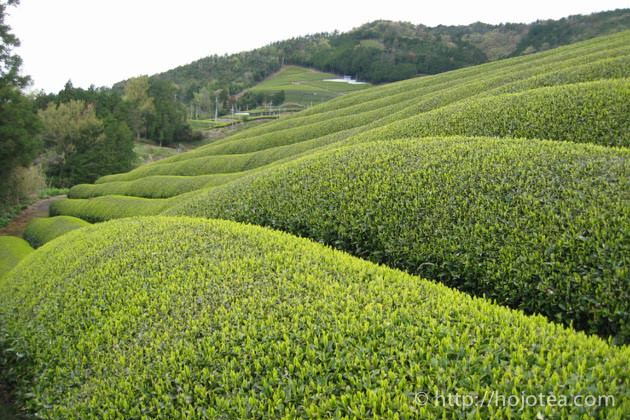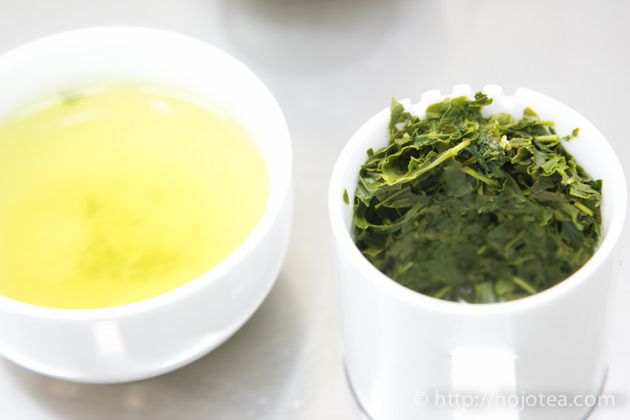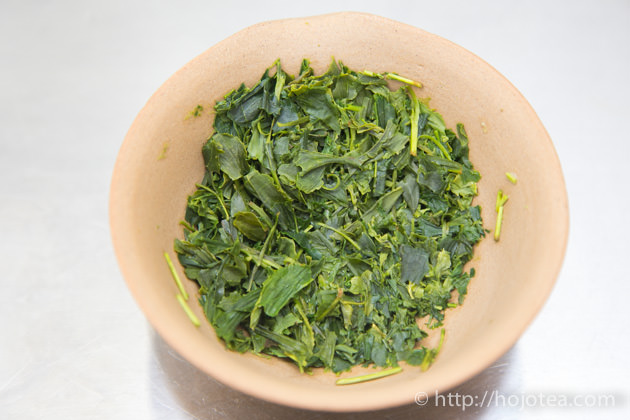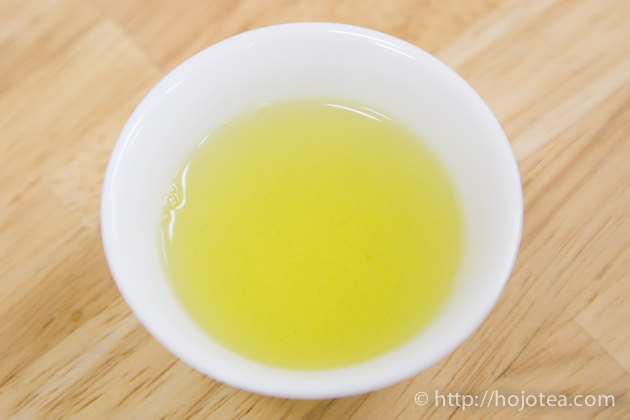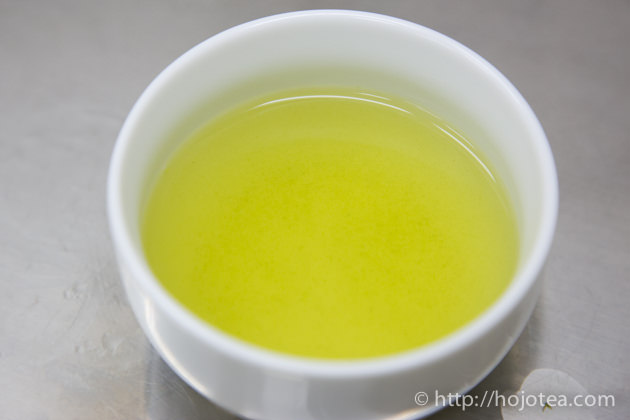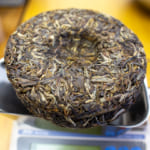- HOME >
- New Arrival at HOJO Online Shop
Rich body and aftertaste, Uji Sencha Fukamushi
We quietly released Uji Sencha Fukamushi last year. Uji Sencha Fukamushi is not an ordinary Fukamushi sencha.
Collaboration between Sencha and Fukamushi Sencha
In Japanese, the “fukamushi” means deeply steamed. Fukamushi sencha is produced following the standard process in making a sencha, but a longer steaming process is conducted compared to ordinary sencha. The sencha is steamed for about 20-30 seconds, while the fukamushi sencha is steamed for more than 1 minute. Generally, fukamushi sencha contains very fine tea leaves as a result of heat destruction caused by the longer steaming process. The Uji Sencha Fukamushi is not a pure fukamushi sencha. It was blended between sencha and fukamushi sencha. Our aim in blending is to balance the cup characteristic in terms of after taste, body and mouth feel. We have selected 3 different types of tea to represent each characteristic.
Uji Sencha Fukamushi gives thick mouth feel, strong after taste and bold body
Uji Sencha Fukamushi has a typical thick mouth feel of a fukamushi sencha as well as strong after taste which is typical of a natural-farmed tea. In addition, the flavour of this tea widely spread on our palate thanks to the thick body.
1. Body
The body is the horizontal sensation on palate. When tea has a strong body, the flavour becomes richer and the sweetness remains at the side of our mouth. Normally, most of Japanese green tea has very less body. It is due to the absence of stem. Unlikely to the old tradition, nowadays most of the tea manufacturers work very hard to remove tea stems on account of the consideration of the appearance: they do think that tea leaf without stem looks more beautiful as it gives homogeneous dark green colour. Ironically, it is the stem that gives body to the taste. You may imagine some vegetables such as celery, spinach, spring onion or any brassica plant. It always is the stem that gives sweetness. The stem of vegetable gives more sweetish taste not because of the existence of sugar but the body. If you have ever tried Karigane (the Japanese sencha made of stems), you would probably understand what I mean. Karigane is a tea contains only stem. It gives extraordinarily strong body. For most of Japanese green tea, the stem is removed with colour sorting machine. You could hardly find stem in so-called quality Japanese green tea. As we were aware of the importance of stem in taste, we have never remove stems so as to increase the body of tea.
2. After Taste
The after taste can be explained as long lasting taste, lingering taste, longer finishing, smoothness, softness or transparency. It is the vertical sensation we feel it through the throat to chest. Generally, most of Japanese green tea lacks the after taste. It is due to the modern agricultural practice; farmers apply excessive amount of fertilizer in order to increase the theanine content. The theanine is the substance which gives umami sensation, a taste very similar to the taste of so-called Ajinomoto. With the addition of fertilizers, tea trees synthesize theanine in order to accumulate excessive nitrogen content. The tea garden managed with the modern agricultural practice generally produces tea which is rich in amino acid. On the contrary, the quantity of poly phenol is in inverse proportion to the quantity of theanine. The naturally-farmed tea produces much higher content of poly phenol, and it gives stronger after taste. We have selected Uji Sencha Jubuzan to represent tea that is in-charge of the after taste.
3. Mouth Feel
The naturally-farmed sencha gives a very deep after taste. It gives clear and transparent sensation when we drink. I wanted to add in the thick mouth feel on the top of the deep after taste. That is why I decided to blend Ujidawara Fukamushi sencha. Ujidawara ( 宇治田原)is one of the towns produces quality Uji sencha.
After blending 3 types of tea, we managed to balance three essential sensations in taste. Thanks to the adequate level of after taste, body and mouth feel, you would feel a three dimensional sensation. Since this tea is very rich in minerals, we suggest high temperature and short brewing method. For our own brewing, we use boiling water and brew less than 20-30 seconds.
Related Articles
How to get the latest update on HOJO?
1. Follow Twitter, 2. Click "Like" on Facebook, and 3. Subscribe in newsletter. You can have the latest tea news from HOJO.
 Subscribe the Newsletter to enjoy the privileges
Subscribe the Newsletter to enjoy the privileges- You may receive a free sample upon purchase, or you may have the priority to purchase special products. So please remember to subscribe our newsletter as well as the social network.
- New Arrival of Akitsu Mumyoi and Nosaka Rough Clay Teapot
- A wide selection of teaware by Watanabe Tozo, a Sado-based artist of Mumyoi-yaki, has just arrived. This time, …
- Mang Fei Ripe Pu-erh Tea 2023 – Small-Batch Production from a Renowned Region
- Mang Fei Ripe Pu-erh Tea 2023 is now available. This is one of the highest-quality ripe pu-erh teas among our …
NEW ARTICLES
 Development of Firewood Roasted Hojicha Using Naturally Grown Tea from Yunnan
Development of Firewood Roasted Hojicha Using Naturally Grown Tea from Yunnan- We are currently staying in Yunnan Province for tea production. As the season nears its end, tea trees with pa …
 Exploring the Food Culture of Yunnan: Where Minority and Sichuan Cuisines Meet
Exploring the Food Culture of Yunnan: Where Minority and Sichuan Cuisines Meet- We are currently staying long-term in Yunnan Province for spring tea production. On rainy days or when there i …
 New Arrival of Akitsu Mumyoi and Nosaka Rough Clay Teapot
New Arrival of Akitsu Mumyoi and Nosaka Rough Clay Teapot- A wide selection of teaware by Watanabe Tozo, a Sado-based artist of Mumyoi-yaki, has just arrived. This time, …
 Managing Yunnan White Tea — Insights from the Field
Managing Yunnan White Tea — Insights from the Field- Since March 25, we have been in Yunnan Province, fully engaged in the production of white tea. In this column, …
 Mang Fei Ripe Pu-erh Tea 2023 – Small-Batch Production from a Renowned Region
Mang Fei Ripe Pu-erh Tea 2023 – Small-Batch Production from a Renowned Region- Mang Fei Ripe Pu-erh Tea 2023 is now available. This is one of the highest-quality ripe pu-erh teas among our …
 Yunnan Tea Trends 2025: Insights from the Fields
Yunnan Tea Trends 2025: Insights from the Fields- Since March 25, we have been in Yunnan Province. We will stay here until May to conduct tea production, packin …
 Why Do Some Teas Taste Astringent? Exploring the Causes and Mechanisms of Astringency
Why Do Some Teas Taste Astringent? Exploring the Causes and Mechanisms of Astringency- Tea can range from having no noticeable astringency to possessing a very strong one. What causes this astringe …
 The Impact of Heat Sources on Tea Flavor
The Impact of Heat Sources on Tea Flavor- It is widely recognized that the material of a kettle plays an important role in shaping the taste of water fo …
 New Release of Tang Li Shan Ripe Pu-erh Tea 2023
New Release of Tang Li Shan Ripe Pu-erh Tea 2023- We have released the 2023 edition of Tang Li Shan Ripe Pu-erh Tea. Tang Li Shan refers to a mountain located o …
 The New Release of Dong Shan Raw Pu-erh Tea 2023 and Jasmine Silver Needle
The New Release of Dong Shan Raw Pu-erh Tea 2023 and Jasmine Silver Needle- We have released Dong Shan Raw Pu-erh Tea 2023 and Jasmine Silver Needle. Dong Shan Raw Pu-erh Tea 2023 We hav …
Category
- New Arrival at HOJO Online Shop
- Featured Articles
- Newsletter
- Types of Tea
- Origin of Tea
- Teapot and Tea Equipment
- Tea Column
- How to enjoy tea
- Tea Processing
- How to choose quality tea
- Tea constituents and functional effect
- Safety of Tea
- Foods
- Tea Business Operation
- Hobby and Outdoor Activity
- Ranking of Tea
- Video
- FAQ
- Media Release
Profile

- AKIRA HOJO
- I invite you to experience my tea selections.I was born in Nagano, Japan. In university, I studied agricultural chemistry, and I have the master degree in food science. I worked in Japanese food industry for 10 years. I involved in R&D, QC and QA. As a factory manager, I implemented ISO9000 series and managed the factory.
- The Art of Tea Magazine
- We posted the article on “The Art of Tea Magazine No.9, the magazine is published in Taiwan. We featured …
- New Straits Times
- The Malaysian National Newspaper, New Straits Times featured HOJO Tea on 17-Oct-2007.
Shop Info

Address:Lot No. T-215, 3rd Floor, The Gardens Mall, Mid Valley City, Lingkaran Syed Putra, 59200 Kuala Lumpur
Tel: +603-2287-4537
Business Hour: 10am to 10pm

